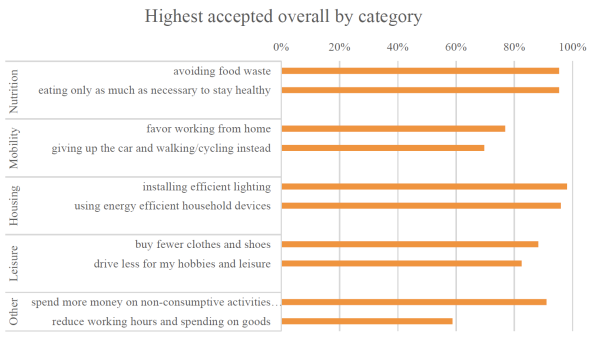
During our Citizen Thinking Labs (CTLs) we exposed more than 100 citizens from 5 European countries to a set of low-carbon lifestyle options to evaluate A) whether they were already implementing them, would be willing to implement them in the near future, or would reject the options, and, B) what the reasons for their choices were.
You can find more information on our Citizen Thinking Labs and the low-carbon lifestyle options on our website. Figure 1 shows the two “most popular” low-carbon lifestyle options per consumption domain (e.g. nutrition, mobility etc.) across our Citizen Thinking Labs.
In the following, we will point out the main motivations of acceptance of our participants and showcase a few country specific differences.

Acceptance was calculated by adding the number of participants who either selected « I am already doing this option » or « I will do this option from now on » and dividing the sum by the number of participants for whom the option was relevant, i.e.: total number of participants minus the number of participants who marked the option as "not relevant" for them. For example, a person who does not own a car cannot “give up the car and walk or cycle instead”, the option would be irrelevant for this person.
In the consumption domain of nutrition, the options “I will avoid food waste at home” and “I will eat only as much as I need to stay healthy” had the highest acceptance rate (95.4% each). Economic factors, i.e. rising food prices and “a better feeling” when wasting fewer resources, were stated as the main reasons and motivations for avoiding food waste. Reasons for not overeating included (improvement of) personal health and potential weight loss.
In the consumption domain mobility, participants expressed a high level of acceptance for “working from home”, reporting that it became an option during the COVID-19 pandemic, poses a lower risk of infection and made it possible to follow their own daily schedule, for example, dedicating more time to sleep. It is noteworthy, that while the acceptance rate was over 75% in 4 country labs (and even 100% in the Swedish lab), it was only 55.6% among the German participants. Reasons for lower acceptance in Germany included the concern that personal and professional life would be blended too much by working from home, and that social exchange and encounter at work after the COVID-19 pandemic were crucial.

The option of giving up one's car in favour of walking or cycling was accepted by 69.7% on average through our CTLs. Again, the acceptance rate in the German CTL was exceptionally low, with 22.2% (77.8% rejection), while for example, Spanish participants accepted it by a rate of 92.3%. As motivations for giving up their car, participants expressed that it was better for the environment and nature, and also healthier because it was an additional physical activity and could hence be enjoyed more. In the German CTL, where this option was very unpopular, people stressed the necessity of their car for managing everyday life, e.g. driving children to activities, and also referred to it as a kind of luxury which allows flexibility and comfort.

In the area of housing, financial/economic motivations played a dominant role. The most acceptable housing options for participants were switching to energy-efficient household devices and lighting. The acceptance rates were at 100% with the Spanish, German, Hungarian and Latvian participants. The primary reason given was energy saving, which also leads to lower costs.
In the area of leisure, the most accepted option was “I will buy fewer clothes and shoes” at a rate of 88.2%. “Voluntary simplicity” played a role in motivation, as many participants reported that they already owned too much, wanted to reduce impulse purchases and did not need more things. The motivation for “driving less for hobbies and leisure” was the wish to reduce emissions and protect the environment. In addition, people mentioned the possibility of saving money, and considered biking and walking a healthy physical activity. For this option, Latvian participants' acceptance ranked below average with a rate of 63%. This was due to the feeling that distances were too long, or adequate infrastructure was lacking.
“I will spend more money on non-consumptive activities instead of buying goods” was widely accepted (91.1%) in the consumption domain of Other. CTL participants considered time spent on activities to be more valuable and fulfilling than buying ever more thing. Time spent with family and friends, on education or on arts & culture was therefore considered more precious and more memorable than buying things. Stopping to buy more “things” was considered positive for personal and mental well-being.
One result of the CTLs is confirming what many already know and experience: Leading a lifestyle that is compatible with climate goals is not synonymous with sacrifice and hardship, but often includes a gain in quality of life in one way or the other.
Disclaimer: Due to the small sample size of citizens per country (20-24) and sometimes an even smaller sample out of those (e.g. when CTL participants did not express opinions on some low-carbon lifestyle options because they were or seemed “not relevant” to them), generalist “European” or country specific conclusions on citizens’ preferences for low-carbon lifestyle options cannot be drawn from our Citizen Thinking Labs. In the future course of the project, we will however use the results to speak of tendencies and trends of acceptance or rejection.
Lena Domröse and Maren Tornow (adelphi)

